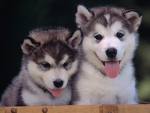Full of Stamina
the Siberian Husky
is a great sled dog
|
|

Please Help Homeless Pets with a One Dollar Gift
Totally Loyal, Siberian Huskies need lot's of Protein
in their diet
Jane Bicks, D.V.M.
Although very different from the Samoyed, the
nutritional needs of the Siberian Husky breed are very
similar.
A high quality protein and fat diet with the
addition of vegetable enzymes should keep the coat
healthy.
This is what I give my support to for the Ultimate Dining
Experience for your Siberian Husky
Brewer's yeast and garlic are great treat choices.
To stimulate the appetite, try Pet Tinic.
Healthy Treats for Siberian
Husky Dogs
Siberian Husky

The Husky is a gentle, playful dog that is very fond of its
family. These dogs remain puppies at heart and are clever,
docile, easy-going, loving and sociable. They are dogs that
have a lot of energy, especially when they are puppies. They
are friendly to strangers and good with children. But they
do not make good watchdogs. They do not bark a lot and just
love everyone.
The Husky was brought to Alaska from Siberia in 1909. They
have been used for centuries by the Chukchi people of
Siberia mainly for herding reindeer and pulling sleds. They
also were used as watchdogs. They were adapted to the harsh
conditions of the Arctic and make perfect working dogs. They
are hardy, and will work together in small packs and have no
problem working for very long hours.
The Husky is a sled dog that is light weight with a great
deal of stamina. They were taken to North America by the fur
traders to Malamute for arctic races because of their speed
and stamina. In 1925 Huskies were used to relay medicine for
the diphtheria epidemic that struck Nome, Alaska. This
focused national attention on the Husky and thereby
popularized the dog breed. The Husky was also used by
Admiral Byrd's expeditions in the Antarctic.
The Husky is an excellent pack animal that gets along well
with other dogs in their pack. They have become a very
popular dog breed as a companion dog. They are also used for
carting, racing and sledding. The Husky is a compact, strong
working dog. They have large snow "shoe feet" with hair
between the toes that helps them grip the ice. The tail is
crescent shaped.
The dog comes in colors from black to pure white. There are
a variety of markings on the head that are common, including
striking patterns that can't be seen in any other dog breed.
Color choices include agouti and white, black and white,
gray and white, red and white, sable and white and white.
These colors can be very light to very dark in color.
Different coat markings including the noted piebald are all
accepted.
The face mask and underbody are almost always white, with
the remaining coat being any of the above listed colors. The
Husky has a soft outer coat and a thick wooly undercoat that
provides enough insulation that the dog can sleep
comfortably buried in snow. A Husky can withstand
temperatures as low as minus seventy-six degrees Fahrenheit
(minus sixty degrees Celsius).
The ears are erect and set high. The eyes are almond shaped,
spaced moderately and set a little oblique. A common
misconception is that all Huskies have blue eyes. The eye
color can be amber, blue, brown and any combination thereof
including one eye being half one color and the other part of
the eye being half another color which is known as parti-
eyed, or their eyes can be one of each color.
Huskies are an independent breed with a definite mind of
their own. They will only obey commands up to a point,
especially if you are a meek person or lack leadership
capabilities. They are very intelligent and trainable but
you must remain calm, confident, consistent and firm when
training. Otherwise this dog can become mischievous and
willful.
All about Different Dog Breeds
Special Gift Ideas for every Dog Breed
|